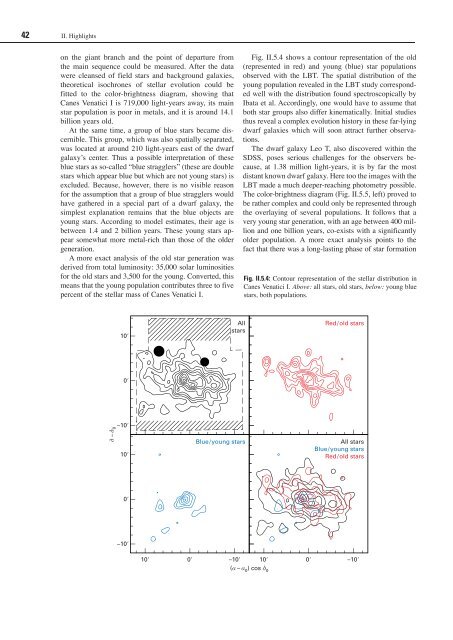Max Planck Institute for Astronomy - Annual Report 2007
Max Planck Institute for Astronomy - Annual Report 2007
Max Planck Institute for Astronomy - Annual Report 2007
Create successful ePaper yourself
Turn your PDF publications into a flip-book with our unique Google optimized e-Paper software.
42 II. Highlights<br />
on the giant branch and the point of departure from<br />
the main sequence could be measured. After the data<br />
were cleansed of field stars and background galaxies,<br />
theoretical isochrones of stellar evolution could be<br />
fitted to the color-brightness diagram, showing that<br />
Canes Venatici I is 719,000 light-years away, its main<br />
star population is poor in metals, and it is around 14.1<br />
billion years old.<br />
At the same time, a group of blue stars became discernible.<br />
This group, which was also spatially separated,<br />
was located at around 210 light-years east of the dwarf<br />
galaxy’s center. Thus a possible interpretation of these<br />
blue stars as so-called “blue stragglers” (these are double<br />
stars which appear blue but which are not young stars) is<br />
excluded. Because, however, there is no visible reason<br />
<strong>for</strong> the assumption that a group of blue stragglers would<br />
have gathered in a special part of a dwarf galaxy, the<br />
simplest explanation remains that the blue objects are<br />
young stars. According to model estimates, their age is<br />
between 1.4 and 2 billion years. These young stars appear<br />
somewhat more metal-rich than those of the older<br />
generation.<br />
A more exact analysis of the old star generation was<br />
derived from total luminosity: 35,000 solar luminosities<br />
<strong>for</strong> the old stars and 3,500 <strong>for</strong> the young. Converted, this<br />
means that the young population contributes three to five<br />
percent of the stellar mass of Canes Venatici I.<br />
– 0<br />
10<br />
0<br />
–10<br />
10<br />
0<br />
–10<br />
10<br />
All<br />
stars<br />
Fig. II.5.4 shows a contour representation of the old<br />
(represented in red) and young (blue) star populations<br />
observed with the LBT. The spatial distribution of the<br />
young population revealed in the LBT study corresponded<br />
well with the distribution found spectroscopically by<br />
Ibata et al. Accordingly, one would have to assume that<br />
both star groups also differ kinematically. Initial studies<br />
thus reveal a complex evolution history in these far-lying<br />
dwarf galaxies which will soon attract further observations.<br />
The dwarf galaxy Leo T, also discovered within the<br />
SDSS, poses serious challenges <strong>for</strong> the observers because,<br />
at 1.38 million light-years, it is by far the most<br />
distant known dwarf galaxy. Here too the images with the<br />
LBT made a much deeper-reaching photometry possible.<br />
The color-brightness diagram (Fig. II.5.5, left) proved to<br />
be rather complex and could only be represented through<br />
the overlaying of several populations. It follows that a<br />
very young star generation, with an age between 400 million<br />
and one billion years, co-exists with a significantly<br />
older population. A more exact analysis points to the<br />
fact that there was a long-lasting phase of star <strong>for</strong>mation<br />
Fig. II.5.4: Contour representation of the stellar distribution in<br />
Canes Venatici I. Above: all stars, old stars, below: young blue<br />
stars, both populations.<br />
Red/old stars<br />
Blue/young stars All stars<br />
Blue/young stars<br />
Red/old stars<br />
0 –10 10<br />
( – 0 ) cos 0<br />
0 –10

















